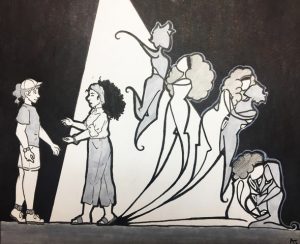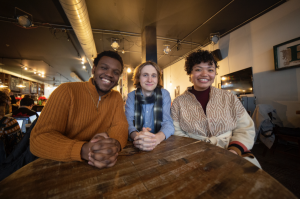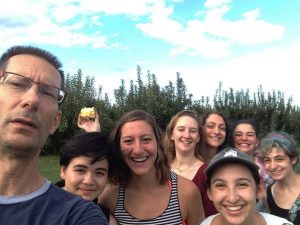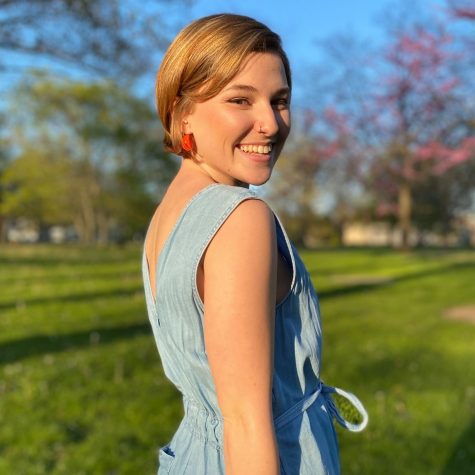Arts & Culture: A Year in “Review”
Editor’s note: This article appears as part of a series in which the Review’s graduating editors reflect on how their sections have evolved, the biggest stories of the year, and their time at the paper as whole. The rest of this series can be found here.
This year, the Arts & Culture section chronicled Oberlin’s lively and unique creative scene, surveying what matters to Obies from a thriving fall semester to an unexpectedly remote spring. Aly Fogel, a College fourth-year and English major, began her tenure as an Arts & Culture Editor this past September and approached the position with specific goals.
“I think it’s really cool to be able to represent not only, ‘Oh, this event happened,’ but ‘What is Oberlin really like? What are the people here like?’ and document that through different [stories],” Fogel said.
One of Fogel’s first pieces, (“A Look Behind the Scenes: Choreographing Physical Intimacy,” Sept. 13, 2019), tackled questions of consent within artistic practice by examining the increased prevalence of intimacy directors in theater and film, and their relevance to theater programs at Oberlin. A performer herself, she had been uncomfortable with the way that some directors had approached intimate scenes in shows that she had performed in. In her reporting for the piece, she had many vulnerable conversations with students and faculty on this issue.

“I tried to capture that nuance in the article while also celebrating that, [for example, Visiting Assistant Professor of Dance] Holly [Handman-Lopez] has been doing great work with intimacy coordinating for a long time and she’s way ahead of the curve,” Fogel said. “In the article, I was trying to capture [that in some] Oberlin shows people are still uncomfortable, but in other areas we are ahead of the curve, as you would assume from this uber-liberal institution.”

The fall semester saw other exciting pieces delving into Oberlin culture, like “In Bittersweet Move, House of the Lord Fellowship Finds New Space,” Dec. 13, 2019, a story about a local congregation’s relocation; “‘Odysseans’ Bond Over Unique First-Year Seminar Experience,” Dec. 13, 2019, about a class that stayed in touch over four years; and “‘Rocky Horror’ Brings Weirdness to Campus for Tenth Year,” Oct. 11, 2019, an article about the annual performance of the cult favorite at Oberlin.

Fogel’s piece “Secrets From Seventeen Years of Long Island Night,” Oct. 4, 2019, explored Oberlin culture in a light-hearted way. Fogel decided that pursuing a piece about the history of Long Island Night at The Feve, a beloved Oberlin haunt, would put a light-hearted spin on local coverage and also paint a genuine picture of Oberlin life. She spoke with Feve owners and employees, as well as with a former boss and Oberlin alumnus who connected her with more alumni eager to share Feve stories.
“I also thought it would be cool if we could do pieces that get at the culture of Oberlin as a city and campus, because Oberlin has such a strong culture,” she said.

In addition to these culture pieces, Fogel wrote investigative stories in the Arts & Culture section. In November, Fogel wrote “All-Female ‘Waiting for Godot’ Cancellation Sparks ‘Collective Rage,’” Nov. 15, 2019, about Oberlin’s planned all-female winter term production of Waiting for Godot, which was canceled after the Beckett estate refused to authorize Oberlin’s all-female cast.
“There are differing opinions on whether Oberlin should be doing canonical works like Waiting for Godot, especially because the Beckett estate had gone to court with theater companies looking to produce the play with all-female casts in the past,” Fogel wrote in an email to the Review. “But I think that what the theater department intended to do with the show, given the all-female cast, would have been really exciting.”
In response to the inability to reinvent the play as they’d attended, guest director Tlaloc Rivas decided in conversation with the department to instead stage Collective Rage: A Play in 5 Betties. This less canonical piece was well-received.
In the last week of in-person classes, as the spread of Covid-19 caused closures of college campuses nationwide, the Review published its last print issue of the semester. Fogel’s co-Arts Editor, College second-year Jaimie Yue wrote a piece on a dialogue event hosted by the Oberlin Chinese Students Association was released in that final issue after students found out they’d be going home. “Amidst COVID-19 Pandemic, OCSA Program Seeks to Promote Open Dialogue,” March 13, 2020, detailed discussions on heightened racism against Chinese people in tandem with the spread of the virus. The article was pitched before Oberlin’s announcement that students must leave College housing, which came unexpectedly later that week, and it was published days before many students left campus.
“That piece already was very meaningful and then in the context of what was happening at Oberlin became even more meaningful published on that Friday,” Fogel said. “I think that Arts definitely does have a role in discussing really big events like coronavirus.”
The first Arts coverage to be published after campus’ closure was a series of pieces responding to a survey on Obie watch habits conducted by Mellon Postdoctoral Fellow and Visiting Assistant Professor of Cinema Studies Leah Vonderheide.
“The reason Professor Vonderheide said that she did the series [was] to make people still feel like they’re connected,” Fogel said. “Which I think is a really interesting aspect of the survey. Because even though everyone’s at home watching or streaming, [this gives you the chance] to talk about this collective experience versus feeling very alone while you were watching.”
The series began with Vonderheide’s analysis of the sitcom The Office in “‘What are you watching, Obies?’ Survey Results: Initial Reflections,” April 13, 2019, and continued with four other article responses to its results.
After campus’ closure, Fogel continued her work with the Review in an Associate Editor position. Producing a college and community weekly like the Review, though, is different with a rolling schedule of coverage and a staff scattered across the globe.
“I missed [everyone] and I missed the atmosphere of working in the Burton [Hall] basement,” Fogel said. “I also really like when I’m working with coworkers to be able to ask someone, ‘Hey, can you read this sentence? It doesn’t sound right. Can you help me?’ … ‘Hey, what do you think the angle should be for this?’ Whereas when I was working remotely, I could do that — I could text them — but it’s just not the same as just yelling it into [that] room or asking the person sitting next to you. So that was a big adjustment.”
Looking back on her time at the Review, Fogel enjoyed the creative possibilities that came with an editor role.
“Having that [editorial] power and responsibility was at times stressful, but also just a great experience where I was really free to explore whatever I wanted to write,” she said. “There are a lot of different lessons I take, but I think looking back, I’m always going to remember the freedom I had working on this paper and the opportunity to cover Oberlin, which is a school and place that I love so much.”










